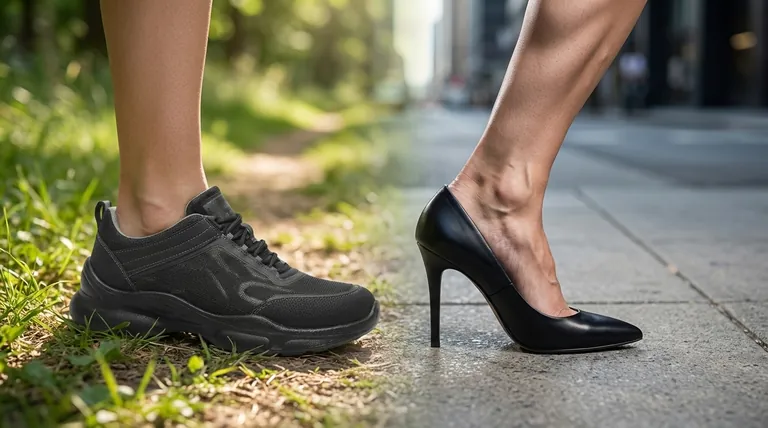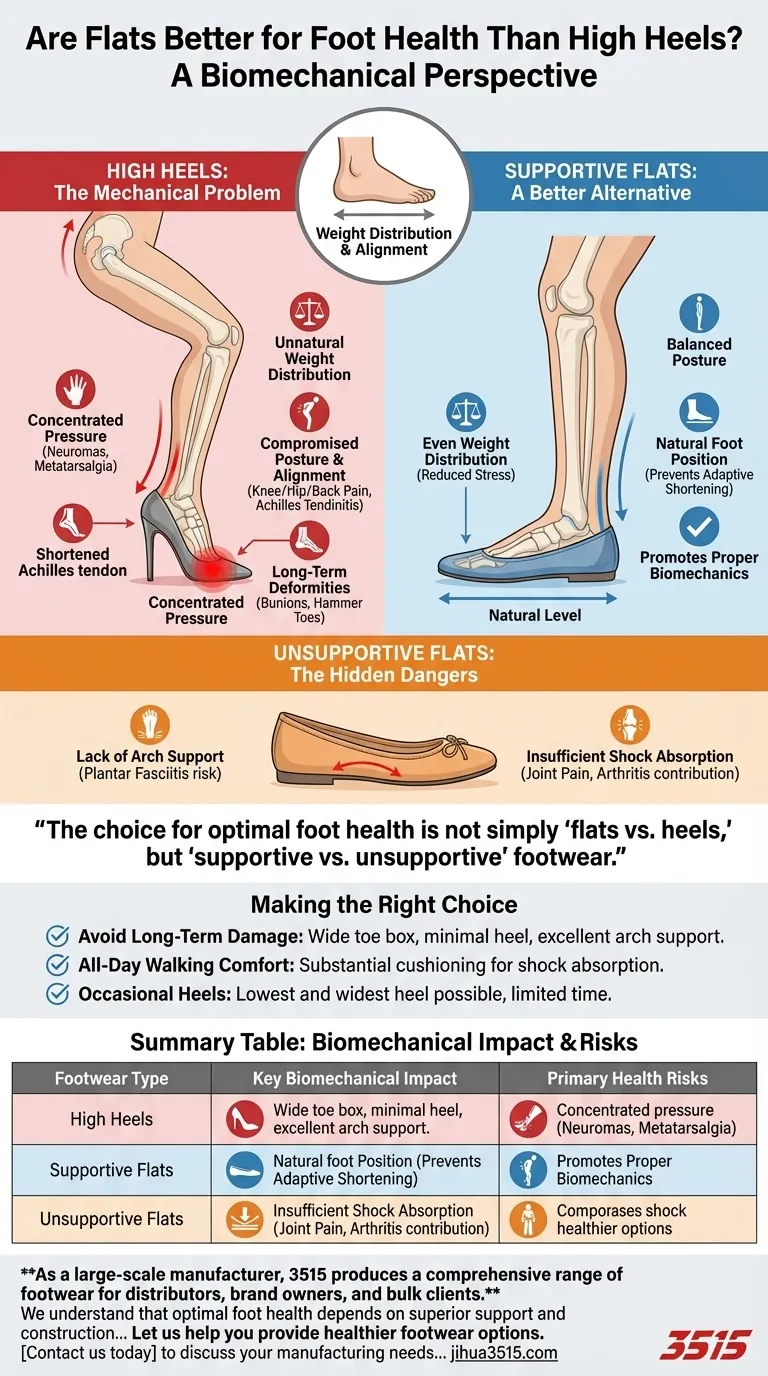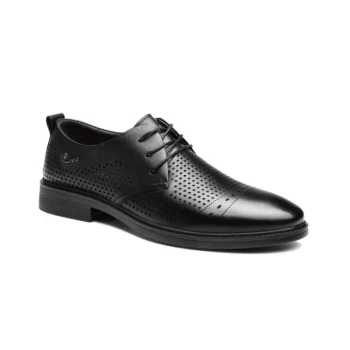From a purely biomechanical standpoint, yes, flats are fundamentally better for your foot health than high heels. Footwear with a lower heel promotes a more even distribution of your body weight across the entire foot, which is its natural and intended function. This drastically reduces the excessive pressure on the forefoot that high heels create, lowering the risk of stress fractures, bunions, and other deformities.
The choice for optimal foot health is not simply "flats vs. heels," but "supportive vs. unsupportive" footwear. While flats are a better starting point, a flimsy, unsupportive flat can create its own set of problems.

The Mechanical Problem with High Heels
Wearing high heels forces your foot into an unnatural, plantarflexed (downward-pointing) position. This alters your body's entire alignment and creates a cascade of negative effects.
Unnatural Weight Distribution
A flat foot distributes your body weight relatively evenly. As you increase heel height, the load shifts dramatically forward onto the ball of the foot and toes.
This concentrated pressure on the metatarsal bones can lead to pain (metatarsalgia), stress fractures, and inflammation of the nerves between the toes, known as neuromas.
Compromised Posture and Alignment
To compensate for the forward pitch of the feet, your knees and hips push forward while your lower back hyperextends. This unnatural posture can contribute to knee, hip, and back pain.
Furthermore, the elevated heel shortens the Achilles tendon and calf muscles over time, leading to tightness, reduced ankle mobility, and an increased risk of injury like Achilles tendinitis.
Risk of Long-Term Deformities
Chronic use of high heels, especially those with a narrow toe box, is a leading contributor to painful and often permanent foot deformities.
Conditions like bunions (a bony bump at the base of the big toe) and hammer toes (an abnormal bend in the middle joint of a toe) are frequently caused or exacerbated by this footwear.
Why Flats Are a Better Alternative (But Not Perfect)
Switching to flats immediately alleviates the primary issues caused by high heels by allowing your foot to rest in a more natural position.
The Benefit of Even Weight Distribution
Flats allow your body weight to be spread across the entire surface of your foot, from heel to toe. This is the foundation of proper biomechanical function and stability.
A More Natural Foot Position
By keeping your foot level with the ground, flats allow your Achilles tendon and calf muscles to remain at their natural length. This prevents the adaptive shortening that leads to tightness and pain.
Understanding the Trade-offs: The Hidden Dangers of Bad Flats
While better than heels, not all flats are beneficial. Many popular styles, like ballet flats or thin sandals, offer virtually no structural support.
Lack of Arch Support
Your foot's arch acts as a natural shock absorber. A flat shoe with no built-in arch support forces the ligaments in your arch, particularly the plantar fascia, to overstretch and absorb excessive impact with every step.
This is a primary cause of plantar fasciitis, a common and painful inflammatory condition felt in the heel and arch.
Insufficient Shock Absorption
A paper-thin sole does nothing to cushion the foot from the impact of walking on hard surfaces. This shock is transferred directly up through your ankles, knees, hips, and lower back.
Over time, this repeated impact can contribute to joint pain and worsen conditions like arthritis. A good shoe needs a sole with substance and cushioning material.
Making the Right Choice for Your Foot Health
Choosing the right shoe requires looking beyond just the heel height and evaluating its core structural features.
- If your primary focus is avoiding long-term damage: Choose footwear with a wide toe box, minimal to no heel, and excellent arch support.
- If your primary focus is all-day walking comfort: Prioritize a shoe with substantial cushioning for shock absorption and a supportive structure that prevents your foot from fatiguing.
- If you must wear heels for an occasion: Opt for the lowest and widest heel possible, and limit the amount of time you spend standing or walking in them.
Ultimately, the healthiest footwear supports the natural function of your foot instead of forcing it into an unnatural shape.
Summary Table:
| Footwear Type | Key Biomechanical Impact | Primary Health Risks |
|---|---|---|
| High Heels | Uneven weight distribution on forefoot; unnatural posture | Bunions, hammer toes, knee/back pain, neuromas |
| Supportive Flats | Even weight distribution; natural foot position | Minimal risk when properly supported |
| Unsupportive Flats | Lack of arch support; poor shock absorption | Plantar fasciitis, joint pain, fatigue |
As a large-scale manufacturer, 3515 produces a comprehensive range of footwear for distributors, brand owners, and bulk clients. We understand that optimal foot health depends on superior support and construction, not just style. Our production capabilities encompass all types of supportive shoes and boots designed with proper biomechanics in mind.
Let us help you provide healthier footwear options. Contact us today to discuss your manufacturing needs and how we can bring supportive, comfortable, and durable footwear to your market.
Visual Guide

Related Products
- Wholesale Breathable Training Shoes Custom Athletic Footwear Manufacturer
- Lightweight Breathable Training Shoes for Wholesale & Custom OEM Manufacturing
- Wholesale Breathable & Cushioned Training Shoes Custom Factory Production
- Durable Rubber-Soled Utility Shoes for Wholesale & Custom Brand Manufacturing
- Wholesale Comfortable Business Casual Shoes Custom Manufacturing
People Also Ask
- Does more ground contact area mean better support? Unlock the Secrets of Stable Footwear
- What are the benefits of athletic-style work shoes? Boost Comfort and Safety for Your Team
- What are the benefits of breathable materials in work shoes? Enhance Comfort & Health for Your Workforce
- How do athletic shoes with non-slip features differ from regular ones? Discover the Grip Advantage
- What are the benefits of breathable mesh in shoe design? Enhance Comfort and Performance



















